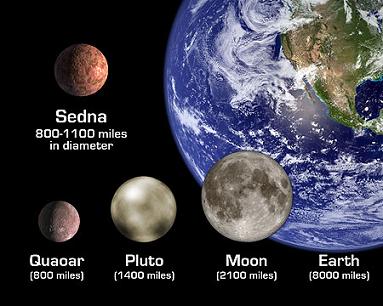Astronomers have discovered a mysterious new body at the farthest edge of the solar system

NASA scientists have discovered the most distant object that orbits the solar system. It is a mysterious celestial body that is three times the distance between Earth and Pluto.
"At this distance, the sun looks so small that it can be completely hidden with the head of a pin," said Dr. Mike Brown, of the Pasadena Institute of Technology, California, who heads the research team. The object, called Sadna after the goddess of the ocean, is 13 billion km from Earth, at the farthest end of the solar system.
This is probably the first time that a body belonging to the Oort cloud has been discovered - a collection of small ice blocks whose existence until now was only a hypothesis, and which are the source of the comets visible from Earth. Sadna is also distinguished by its size and reddish color. It is the second reddest object in the solar system - after Mars. It is estimated that the size of Sadna is about three-quarters the size of Pluto, and it is probably the largest object discovered in the solar system since the discovery of Pluto in 1930.
Sedna was discovered on November 14, 2003 by Brown and other researchers, using the 48-inch diameter Samuel Ocean Telescope at the observatory near San Diego. Within a few days the object was also detected by telescopes in Chile, Spain, Arizona and Hawaii and now it has also been detected by NASA's new space telescope, Spitzer.
A workshop is extremely far from the sun. It is in the coldest region of the solar system, and temperatures there never exceed minus 240 degrees Celsius. It is usually even colder in Sedna, because during Sedna's 10,500-year orbit around the Sun, it only approaches it slightly. At the farthest point of the orbit is a workshop at a distance of 130 billion km from the Sun - 900 times the distance between the Earth and the Sun.
Since the Spitzer telescope was unable to measure the heat of the distant star, the scientists estimate that the diameter of Sadna is smaller than that of Pluto and does not exceed 1,700 km. Sadna's elliptical orbit is unlike anything seen before, and is reminiscent of other orbits of objects in the hypothesized Oort Cloud - a distant collection of comets. However, Sadna is ten times closer to Earth than the estimated distance of the Oort Cloud. Brown estimates that the inner part of the Oort cloud was formed billions of years ago when an elderly star hit the sun and ejected comet-like bodies.
"The star was brighter than the full moon, and was visible in daylight for 20,000 years," Brown explains. The comet shower that spewed out as a result of the impact could have wiped out all forms of life that existed on Earth at the time.
In the coming years, Sadna will approach the Earth, but even at its closest point, in about 72 years, it will be very distant - even far from Pluto. It will then begin its 10,500-year journey again, at the farthest end of the solar system. "The last time Sadna was at this distance from the Sun, the Earth was at the end of the Ice Age. The next time he reaches this point, the world may be completely different again."
